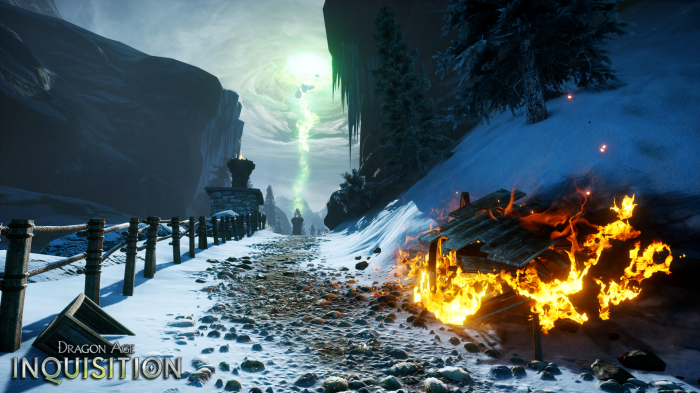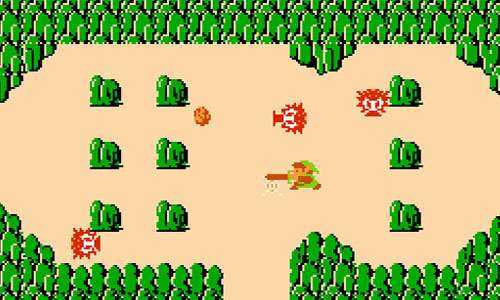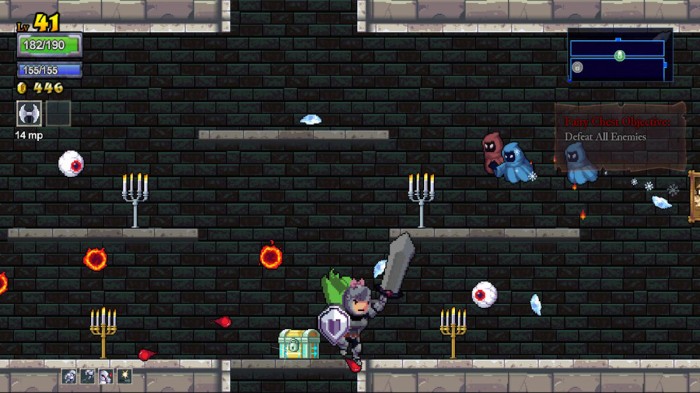The nature of the game industry is changing. As a product, video games stabilized in the post crash 90’s behind four or five major console makers with standardized products. I bet you can’t remember a PacMan 2. In contrast, what about Megaman 1 through 10? Sequels are a sign of an industry figuring out what works and going back to proven formulas. During the console reign,the PC hobbyists maintained an underground culture (as those who came before spoke of physical cards and boards, and whisper still), but innovation during the big console era was largely dictated rather than discovered. For many hardware cycles the tip of progress was pointed at visual fidelity, a pleasant but non-inflammatory form of innovation. Finally however, with the cracking of the marketplace by independents like Valve and Oculus, the bedrock of gaming is again uncertain. The once-flagship product, a $50-60 boxed software promising some 20+ hours of offline content, is now floundering. It’s not the bread-winner anymore, at least not in the shadow of mobile juggernauts and worldwide paid persistence machines which measure their success not by millions sold but by millions made per day. After years of gamers swearing up and down that games were a product, not a service, we now find them firmly in the service category. On my phone, over half of the games that I have installed will simply not work without a server connection. The flip side of this is I can also put my phone in a lensed case and experience 1:1 virtual reality. The revolution is neither good nor bad (nor televised). With the end of the tent pole we also get a tidal wave of talented indies. And it certainly seems like developers are trying harder than they used to, wading into the forums to promise/apologize profusely. What did this mean for the last year in gaming?

Last year, I spent a lot of time with one of the last gasps of the tentpole; Dragon Age: Inquisition. The title is indicative of the laborious adjustments that went into making this big budget cargo ship work in the new era. Inquisition, or DAI, is not exactly an artifact. It most closely resembles the persistent worlds typified by World of Warcraft (a big skinner box with a million systems packed in to keep the casino floor busy). In the case of Blizzard’s mind trap and their ilk, the goal is to keep the player paying monthly. DAI doesn’t gain profit with increased playtime, but instead seeks to convert the MMO tricks into the appearance of quality and sustenance. How else to compete with undying games like Ultima Online, which just marked its 18th birthday? If a game has 10 hours of good content, it better be the best rollercoaster this side of the newest Bourne film to justify losing a few days on the thousand hour grind in a different game. Inquisition does this by making you feel like you are grinding for hard-earned baubles and raid gear on your lonesome.
Every plant and rock is bristling with tiers and systems to occupy your mind. Your keep, a sort of home base to plan operations, also serves as quest hub and craft station. Missions are streamlined, they’re provided to the player on a map as a defacto list of things to do, complete with big honking indicators if it’s a world shaking event. I actually appreciate the streamlining and the infinitely expanding inventory. There’s a whole class of items that are designated as vendor trash as soon as you pick them up. These items are uniquely named for flavor, or maybe because calling things vendor trash tier III is too cynical? The take home of these details is that this is a game-game, a ponderous content stuffed outing that a neophyte would never get through even a portion of before bouncing off in boredom, while only an expert gamer could be so possessed by the systems that they miss the repetitiveness. And there’s the rub.
 |
| Mmm… systems… |
Playing Inquisition is a methodical process, like eating a cobb of corn. You work the bits closest to the start, till you get to the bits near the end, with the same slow steady rake for baubles and (!) points of interest. And corn. This also makes it relatively flat, as few of the systems allow you to really make tactical choices. There’s also not really a story arc, a moment of change in the player character. Sometimes NPCs express doubt you can beat the bad guy and get to the end of the game, although we know a bit better don’t we? Note that in this particular case the ending is clipped, the true epilogue shuffled into a post hoc solicitation (DLC), which perfectly encapsulates the cynical financial underbelly of the project. Still, corn is pretty good right? All of the pieces work well. It’s legitimately exciting to raid down a dragon in the end game, and your constant computer companions make the world seem alive. Finally, the excellent codex makes a return, stuffing writing into the cracks of the game to give history and philosophical tradition to what were previously just design choices. This is a bigger flashier product then Dragon Age II, it reaches out with the scope of Dragon Age I and seems to have a million things to do. It’s also impersonal, coldly modern, a design document given flesh.
A slightly more straightforward take on “systems” is Blizzard’s foray into the MOBA genre, Heroes of the Storm. If you don’t know what a MOBA is you should, it’s basically the soccer of competitive gaming and it has already wedged itself into the younger zeitgeist with multimillion dollar tournaments and with ground level streamers generating ESPN levels of blather. It might take a few years, but soon LOL and DOTA will be instantly recognizable acronyms like ABBA. Heroes, or HOTS, is late to the party (deeply ironic since Blizzard unintentionally started it) but they’ve come busting the door down already a little red and sweaty. HOTS dropped into beta fully formed, a slickly competitive 5 on 5 arena game tuned up for speed compared to its cousins. Decision making is de-emphasized while character control takes precedence. Perfect positioning and aim make the difference, although the roster has been growing large enough that strategic options have been expanding.

Pictured : Typical HOTS clusterfuck
So what do you do in this game? You play, then you level, then you manage your gold, then you repeat. The searing highs and pummeling lows of this type of game are all in the moments, the highlight reel. A narrow escape (click click click), a well timed push to the goal (clock click clack), or a psychic read on the enemy troop movement (clonk clap cloink). The end of each match looks almost exactly the same whether you win or lose, and since even ranked or “league” matches place you in pools of thousands, each game is more akin to a preseason basketball game. Very nice but nobody really cares, and that’s your lot. You have to play for the love of the game, the honing of your craft. I think that’s quite respectable, and there are impressive feats of cyber athleticism on display across the esport genre, from the fifteen fingered Korean Starcraft champs to the Counterstrike Europlayers with fighterpilot senses. They’re all quite impressive and even for the average joe, the game, the sport, is quite fun.
I just think it’s weird that this is the type of game that has broken gamers into the mainstream. The MOBA marketshare is insane; most young people know about at least two games now, and the one without an italian plumber is a hypercomplex military RPG hybrid. Before, the really stunning games that defined the conversation in the tentpole generation were jealous of movies; Solid Snakes, Call of Dutys, flights of Final Fantasy, even the original game that incubated the MOBA hybrid, the ultra-dramatic Warcraft 3. These games never crossed over to the rest of the population. People didn’t want games, what people really wanted was sports.
I got through one more game this year, but it wasn’t a recent one. It was the crusty old grandfather of fandom, the original Legend of Zelda. Zelda(the Legend of anyway) is still quite playable in all of it’s 8-bit glory, it’s loop is all learning from mistakes and show don’t tell mechanics. You wander the dusty plains looking for who knows what, but the mystery and craft in this game is insane. It feels like a place, a moment in time, forces working for and against you. Some of the beats may be overly cryptic, but that also lends to an interesting idiosyncrasy. The limitations of Zelda’s construction required hand built levels, meaning nearly every screen is a discreet puzzle, a new take on some enemy placement or line of sight. This is an alternate line of evolution, it’s neither sport nor movie. Certainly later Zeldas would become more cinematic, but there’s a special joy in a game where the visuals and systems are part of a thematic whole. When I beat it, I felt like I had gone on a journey and brought something back with me. This is a sort of experience that skinner boxes are missing, the pureness of a GAME, a designed engagement system. Papering over actions with menus, wait times, meta currency, and progress bars doesn’t make up for that sincere engagement.
 |
| Mostly just wanted to brag about my OG cred of course |
For both Dragon Age and HOTS, the time to stop playing is when you just peter out, when you feel like the improvement curve isn’t giving you enough juice anymore. Despite that, these two games soaked more hours from me than nearly anything else. I feel they must be the games of the year, they were certainly compelling and fun. And in the case of HOTS, it really is a sport, with depths of knowledge to plunge into and skills to refine. But I also feel we should exercise caution going down this road, that as gamers we should think about resisting the high they give. Maybe the best we can hope for is to compartmentalize games rife with skinner systems carefully. Let’s stay gamers and not junkies. Play lots of different things! You can stop any time you want!
 |
| Every move is a tactical decision in Rogue Legacy |
As always, indie darlings provide some respite from this, perhaps due to the fact that people who grow up listening to prog rock often write prog rock. Some of the ones I got to this year include: Counterspy, a charming Cold War take on the old Rogue Squadron corridor shooters, Rogue Legacy, a rogue-like weaponized to crack cocaine levels, and Hohokum, a mellow exploration trip through some brightly colored landscapes. See you next year.
Originally published on Synthetic Error November 29, 2016
Comments
Post a Comment